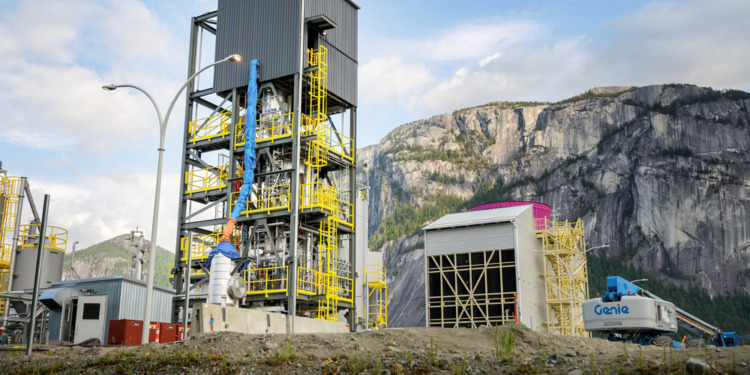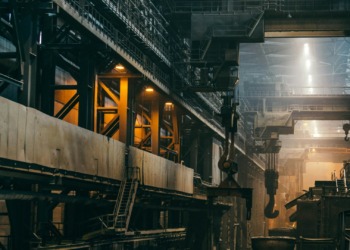As the international community galvanises in the wake of the IPCC’s Sixth Assessment Synthesis Report (AR6), which highlights a rapidly diminishing window of opportunity for international efforts to reasonably hit net-zero targets, the need to take stock of decarbonisation interventions across the board seems more critical now than ever. Carbon capture technologies are one such group of interventions which, in recent years, have been increasingly touted by the IPCC, governments and industry alike, as essential to achieving global net-zero goals.
Although best described as in their technological infancy, a recent study conducted at Lehigh University presents a novel carbon capture method specifically for direct air capture (DAC), which removes carbon dioxide from the atmosphere up to three times more efficiently than current technology.
Given the immediacy of action necessarily implied by the IPCC’s AR6, the promise of this technological advancement must be considered in the context of the global challenges we face.
That said, how important is DAC really going to be in achieving net-zero targets? What opportunities does this new technology present? And, what questions remain?
Carbon Capture: What’s the big deal?
The basic idea of carbon capture is to remove CO2 from the atmosphere and redivert it into useful industrial processes, or store it in a way that permanently excludes it from acting as a greenhouse gas and contributing to a rise in average global temperature.
On the 4th of April 2022, the IPCC explicitly mentioned carbon capture and storage as a key strategy to keeping global temperature increases within 1.5 – 2°C, in line with the Paris climate agreement and 2050 net zero goals.
As the global energy sector transitions away from fossil fuels and towards renewables, carbon capture theoretically offers essential mitigation and low-carbon energy, allowing international demands to be met whilst vital technologies and infrastructure continue to develop.
The IEA even suggests that alongside bioenergy usage, carbon capture and storage offers coal and gas plants operating at high capacity the chance to achieve negative emissions, which, despite ongoing efforts, is yet to be achieved in reality.
Besides, beyond 2050 and the need to achieve net zero, carbon capture is also implicated in an alternative climate narrative which claims mitigation for net zero doesn’t go far enough; that of climate restoration.
In Peter Fiekowsky’s groundbreaking book “Climate Restoration: The Only Future That Will Sustain the Human Race,” a critical point is raised. Namely, that even if we reach Net Zero by 2050, to truly solve our climate issues we must still remove one trillion tons of polluting CO2 from our atmosphere.
Give the gift of #ClimateRestoration!
It not too late for holiday presents. And it's not too late for the climate. https://t.co/99IjpI414y@CaroleDouglis pic.twitter.com/pAQDreDMOM— Peter Fiekowsky (@pfiekowsky) December 22, 2022
In line with the emerging ‘One Health’ approach, the importance of this message cannot be understated, where returning the climate to it’s pre-industrial state is intrinsically tied with the health of the biosphere and all it’s interlinked components, including humans.
Whilst climate restoration projects such as ocean re-seeding and rewilding are continuing to rise in popularity across the globe, offering constructive and positive ways to remove atmospheric carbon and restore nature, other technologies flagged by Fiekowsky are yet to yield results as readily as predicted, including carbon capture.
Where climate restoration proponents claim their related projects work perfectly in adjunction to international net zero accords, both IPCC and climate restoration proponents independently identify carbon capture as central to their projects success. So, what’s the current state of play?
Assessing the carbon capture landscape…
As things stand, carbon capture is carried out in numerous contexts, each with a slightly different purpose.
Carbon capture at the point sources of emissions, otherwise known as CCS, is used to limit the industrial release of carbon dioxide in high-emission environments. CO2 is transported and stored, typically in disused fossil fuel reservoirs or in permeable rocks deep underground.
Despite CCS being the most widely utilised carbon capture method, the IEA points out that as of 2022, only 35 facilities carrying out this process exist globally, accounting for just 45 million tonnes per annum of carbon capture.
Having said that, according to a 2022 report by the Global CCS Institute, although unclear on timelines, increased investment means that the carbon capture capacity of all CCS facilities under development sits at 245 million tonnes per annum.
Where CCS is achieving the explicit goal of reducing carbon dioxide released into the atmosphere, in 2021 the UK alone emitted 425 million tonnes of CO2, demonstrating emissions still far outpace projected technological capacity, and its current successes must be understood as limited.
Related Articles: Direct Air Capture: Resource Considerations and Costs for Carbon Removal | Large-Scale Carbon Capture is Finally Underway | To Unlock the Potential of Direct Air Capture, We Must Invest Now | 6 Ways to Remove Carbon Pollution From the Sky | Iceland Introduces World’s Largest Carbon Capture Machine | The Profitable Equation of Carbon Removal | The Road To Net Zero: A Guide To The Carbon Offset Ecosystem | The Climate Debate Has Turned Explosive: From Apocalypse Doom-sayers to Climate Fixers
Whilst premised on the same principles of capture and storage as CCS, DAC differs in its precise goal; rather than limit CO2 emissions at source, DAC seeks to reduce ambient CO2 levels overall.
Given DAC is designed to process ambient air, with a much lower average CO2 concentration than would typically be found at point source, increased technological and energy demands contribute to a massively raised average cost for capture and storage. Per ton, CCS costs range from US$15-120, compared to a range of US$600-1000 for DAC.
This largely accounts for the limited coverage of DAC, where 18 plants currently operate globally, accounting for only 0.01 million tonnes of CO2 removal per year. To add further important context, the IEA states that just to reach Net Zero by 2050, DAC technology would have to scale up to capture 980 million tonnes of carbon dioxide per year.
Despite limited impacts and elusive economics, the political and industrial will for carbon capture continues to gain momentum.
For example, Shell continues to push the EU for developments in its carbon removal certification framework as it deepens its investment in carbon capture technology development, Denmark has opened the first cross-border CO2 storage site and more broadly, global investment in carbon capture has reached a record high of US$6.4 billion dollars.
From 2015 to 2019, Shell’s Quest carbon capture & storage facility located in Alberta, Canada, captured 5 million metric tons of carbon dioxide — but emitted 7.5 million metric tons of greenhouse gases during the same time period
Read the full thread: https://t.co/3lgKwG3RU5 pic.twitter.com/rjKK9VRsCs
— NowThis (@nowthisnews) January 22, 2022
It’s becoming clear that despite increasing consensus surrounding the need for carbon capture, reflected in investments and projects, the current landscape does little to highlight it as an effective tool serving either net zero or climate restoration goals, as things stand.
Instead, what is also made clear, is the sheer level of development required to make carbon capture a meaningful string in the global decarbonisation bow, which for DAC, a new study from Lehigh University suggests may be just around the corner.
Promising new DAC development?
DAC functions by pulling air through a series of chemical filters and sorbents which become saturated with isolated CO2. Where filtration methodology largely underpins the efficiency of the process, a team at Lehigh University have used the addition of copper to an amine-based sorbent to improve the efficiency of CO2 removal by a factor of three.
'To my knowledge, there is no absorbing material which even at 100,000 ppm, shows the capacity we get it in direct air capture of 400 ppm," said lead author Prof Arup SenGupta from Lehigh University in the US.' https://t.co/j0LvySteEc@ManasB_Official
— Nirmalya Sengupta (@baatchitweet) March 20, 2023
Professor of Chemical and Biomolecular engineering, Arup Sengupta, a primary author of the study, stated that the novel interaction between nitrogen atoms in the amine material and copper mean “an ultra-low concentration of CO2 is no longer an obstacle to [the DAC] process.”
Improved efficiency of the CO2 capture process directly tackles the high energy demands and costs currently preventing DAC applicability. However, the benefits of the study do not stop at efficiency gains, as it goes on to highlight another positive by-product of the technique.
As well as the high cost of capture, Sengupta’s team also seemingly solve persistent storage issues. It was found that when the CO2-saturated copper-amine material was brought into contact with seawater, bicarbonate of soda was formed, which is a harmless alkaline material that can theoretically be safely stored in the ocean.
Carbon dioxide captured from the air could be turned into baking soda and stored in the world’s oceans, thanks to a newly identified material researchers say could revolutionise the direct air capture industry https://t.co/9PSS3qPJ7X
— New Scientist (@newscientist) March 18, 2023
Whilst the study appears to explicitly tackle the two largest limitations underpinning both DAC carbon capture more broadly, it is important to remember that whilst results point to a potentially exciting new chapter for DAC, laboratory conditions do not reflect the real world, and various important questions remain to be answered.
Firstly, the effects of dumping massive amounts of bicarbonate of soda on ocean ecosystems are not clear, and the scalability of the technology is largely unconsidered. It further remains unclear how quickly these questions, amongst others, are able to be addressed.
The idea that CDR technology like direct air capture is definitely going to scale and fall in cost in the same way wind and solar scaled did seems…….problematic, to say the least
Concentrating solar thermal, for instance, received huge amounts of support during early phase.. pic.twitter.com/EKsUjeDyQV
— Ketan Joshi (@KetanJ0) March 15, 2023
Decarbonisation: Stepping back to move forwards
Overall, the carbon capture issue presents an interesting question.
Given the sheer scale of investment and development required to make DAC and similar technologies meaningful over such a limited timespan, why are they continually thrust onto centre stage by organisations like the IPCC and IEA?
More than that, why do these technologies receive so much support from big oil and other industry actors?
One possibility worth consideration, is that the desire for international agencies to find a single technologically-neat solution, alongside the drive for industry actors to shape a future in which they remain at the centre of the climate narrative, may feed into a narrow conception of carbon capture and ultimately distract from the core goal: To lower atmospheric CO2 levels as effectively as we can, now.
To be clear, this is not to say that the results published by Professor Sengupta and his team are unimportant. Technologies like DAC will surely form a key component of the holistic approach needed to tackle decarbonisation positively, and investment in DAC advancement is more than justified.
But, an over-reliance on what remains an underdeveloped technology risks the occlusion of other important interventions that are available now.
Realizing Affordable and Achievable Climate Restoration for the Safe Harbor of Humanity with Peter Fiekowsky https://t.co/jml7Q1pNWG
— Lynn Hellerstein (@LynnHellerstein) March 22, 2023
As pointed out by Fiekowsky and other climate restoration advocates, economically feasible, scalable and attention-worthy decarbonisation interventions both already exist and need more attention, such as synthetic limestone production, seaweed permaculture, ocean iron fertilisation and enhanced methane oxidation.
Perhaps it is important now more than ever to break free from the dichotomy that arises between a narrow “net zero” approach, as represented by international climate organisations and industry, and the search for more explicitly open and constructive approaches to lowering atmospheric CO2.
Perhaps it is time for genuine climate restoration.
Editor’s Note: The opinions expressed here by the authors are their own, not those of Impakter.com — In the Featured Photo: Squamish Carbon Engineering Direct Air Capture (DAC) carbon capture plant Featured Photo Credit: davidbuzzard










